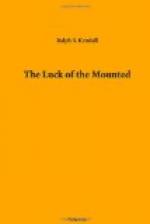His twinkling orbs under their black smudge of eyebrow appraised the junior constable with faint, musing interest. “A quare chap is Yorkey,” he continued gently—shielding a match-flame and puffing with noisy respiration—“a good polisman—knows th’ Criminal Code from A tu Z—eyah! but mighty quare. I misdoubt how th’ tu av yez will get along.” He sighed deeply, muttering half to himself, “I may have tu take shteps—this time! . . .”
A rather ominous beginning, thought George. But, curbing his natural curiosity, he resolutely held his peace, awaiting more enlightenment. This not being forthcoming—his superior having relapsed once more into taciturn silence—he turned again to Yorke’s exhibits with pondering interest. Sounding far-off and indistinct in the frosty stillness of the bleak foothills came the faint echoes of a coyote’s shrill “ki-yip-yapping”—again and again, as if endeavouring to convey some insidious message. George continued to stare at the pictures. Gad! what a strange fantastic mind the man must have! he mused—what rotten, erratic desecration to shove pictures indiscriminately together like that! . . . Lack of space was no excuse. Millet’s “Angelus,” “Ally Sloper at the Derby,” a splendid lithograph of “The Angel of Pity at the Well of Cawnpore,” Lottie Collins, scantily attired, in her song and dance “Tara-ra-ra-boom-de-ay,” Sir Frederick Leighton’s “Wedded,” a gruesome depiction of a Chinese execution at Canton, an old-fashioned engraving of that dashing, debonair cavalry officer, “Major Hodson,” of Indian Mutiny fame, George Robey, as a nurse-maid, wheeling Little Tich in a perambulator, the grim, torture-lined face of Slatin Pasha, a ridiculously obscene picture entitled “Two coons scoffing oysters for a wager,” that glorious edifice the “Taj Mahal” of India, and so on. “Divarsiment” indeed!
To this ill-assorted admixture three exceptions only were grouped with any sense of reason. The central picture was a beautifully coloured reproduction of Sir Hubert Herkomer’s famous masterpiece “The Last Muster.” Lovers of art subjects are doubtless familiar with this immortal painting. It depicts a pathetic congregation of old, white-haired, war-worn pensioners attending divine service in the chapel of Old Chelsea Hospital, with the variegated lights from the stained-glass windows flooding them with soft gentle colours. Flanking it on either side were portraits of the original founders of this historical institution in 1692—Charles II (The Merry Monarch) and his kindly-hearted “light o’ love” Sweet Nell Gwynn of Old Drury.
With curiously mixed feelings George finally tore himself away from Yorke’s pathetically grotesque attempt at wall-adornment. Strive as he would within his soul to ridicule, the pictures seemed somehow almost to shout at him with hidden meaning. As if a voice—a drunken voice, but gentlemanly withall—was hiccuping in his ear: “Paradise Lost, old man! (hic) Paradise Lost!”




